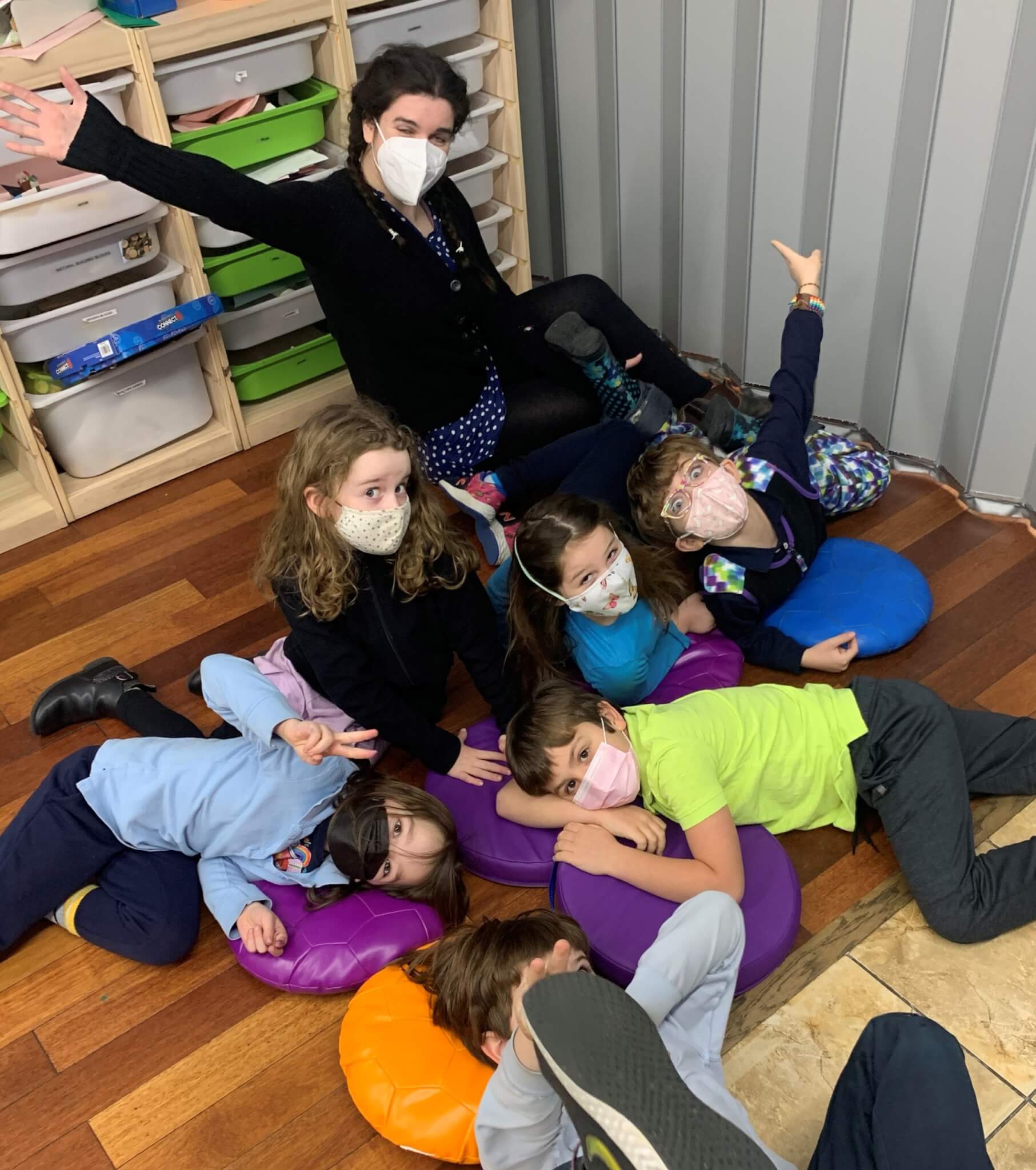
Tu Bishvat higiya – the 15th of Shvat is coming Sunday night to Monday, January 16th-17th! It is time to celebrate the second of four Jewish New Year holidays, the birthday of the trees.
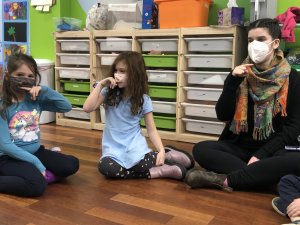
The Garinim (kindergartners) started off our week scavenger hunting around the classroom for Tu Bishvat facts. We read books about trees, created tree sculptures out of telephone wire, and played a tree leaf matching game.
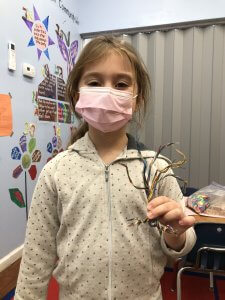
On Wednesday we watched a video telling the story of Honi HaMe’agel, Honi the circle maker. There was a drought in Israel – plants weren’t growing, trees were dying, and the people were hungry and thirsty. They went to Honi for help. He drew a circle on the ground, stood in it, and prayed to God, threatening to not leave the circle until God made it rain. It worked!
Why do you think Honi’s plan worked? Why did it lead to rain?
- Maybe because he and God are friends.
- Maybe because he and God are brothers.
- Because when Honi talked to God, God finally saw that the people really needed the rain.
- Maybe it’s like in the leaving Egypt story where God probably already knew that the Hebrews were slaves but only sent help after the Hebrews cried out. God already knew about the drought but only sent rain after Honi cried out for it.
What do you think it was like for Honi to be faced with this really big problem (a drought) that he couldn’t actually control or solve?
- Very crazy
- Hard
- Difficult to talk to God
- Happy to be able to help the people make their crops grow but also disappointed at needing to stand around talking to God all day.
- Sad that he couldn’t just make it rain himself.
Did drawing a circle to stand in make a difference? Why did Honi do that?
- Because that’s where God could see and hear him.
- To help God notice the ground and how it needed rain.
- He did it just to know where to stand and keep himself in place.
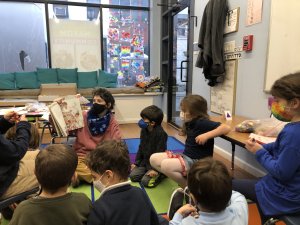
We imagined and explored some other methods that people might use to respond to a big problem they don’t have control over or don’t know how to solve. We determined that not all of these methods would change the situation or fix the problem, but all of them could help us manage our own feelings, which is at least as important.
- Praying
- Singing to myself or with other people
- Writing a story about my experience or reading someone else’s story about a similar experience
- Talking about it with my friends and family
- Cuddling my pets or stuffies
- Making art about my feelings
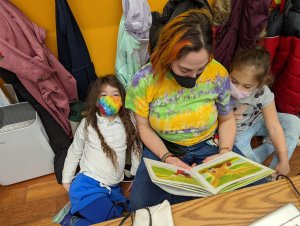
On Monday, the Shorashim (1st and 2nd graders) reviewed the creation story and a text from Ecclesiastes 7:13 saying, “When God created the first human, God took them and showed them all the trees of the Garden of Eden and said to them, ‘See my works, how beautiful and praiseworthy they are. And everything that I created, I created it for you. Be careful not to spoil or destroy my world – for if you do, there will be nobody after you to repair it.’”
Shorashim wondered whether the world was created for humans or something else:
- We are the most important
- Neither because the world was created for all animals and humans are animals
- It was made for trees and animals
We also unpacked what praiseworthy meant:
- Something good
- Like when you help a friend
- Being smart
- Not bragging about being smart
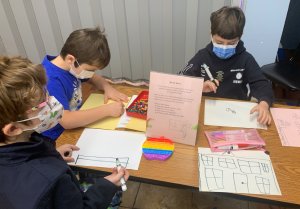
On Tuesday, we watched a read aloud of the book, Follow the Moon Home, which is a story about kids trying to make a difference in their community by saving loggerhead turtles. We wondered about the responsibilities God gave the first humans in this week’s text and related it to our own lives.
Through a think, pair, share, Shorashim wondered about:
- What are ways we show responsibility at Makom?
- being kind
- Being helpful
- following Makom and Shorashim rules
- Following our class brit
- What are ways we show responsibility in the world?
- being kind
- not littering
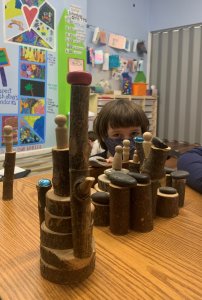
On Wednesday, Shorashim watched another read aloud of the book, “Good People Everywhere”. One of the pages included a carpenter repairing damaged houses and fences in the middle of the woods and one student pointed out how this could negatively impact our environment. They talked about deforestation and how knocking down acres of trees is harmful to the animals and our oxygen quality.
As a class, we brainstormed ideas to combat this:
- Not taking more than we need
- Build houses incorporating the trees (treehouse)
- Build houses out of different materials
- Renovate in already existing homes.
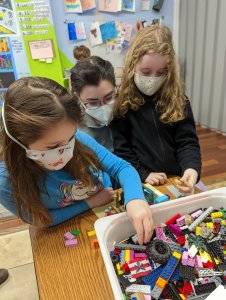
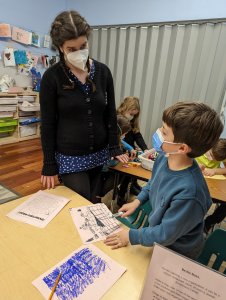
On Thursday, we talked about things Tu Bishvat and read, “Happy Birthday, Tree!” We wondered how we could let a tree know that it was it’s birthday:
- Decorate the tree
- Put flags around it
- Give a tree a gift of soil in a heart shaped box

This week, Nitzanim (3rd, 4th, and 5th graders) explored what it means to inherit a world. What is our responsibility to our world? What makes our world praiseworthy? What is our role in this world? We used this text as a lens to ponder the answers to these questions: “When God created the first human, God took them and showed them all the trees of the Garden of Eden and said to them, ‘See my works, how beautiful and praiseworthy they are. And everything that I created, I created it for you. Be careful not to spoil or destroy my world – for if you do, there will be nobody after you to repair it.”
Here are some reflections from our discussions about our responsibility to the world:
- Destroying the world might look like:
- Pollution
- Ruining a watershed
- Deforestation
- Climate change
- We have seen examples of destruction, but our whole world isn’t destroyed
- Since there is no one after us to repair the world, it’s our job to maintain it
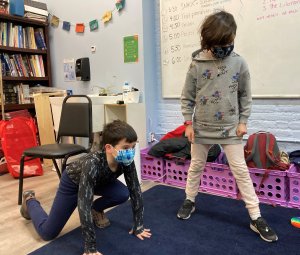
We played an improv game called “Freeze!” in which two kiddos would act out a scene suggested by the audience. A member of the audience would clap and say freeze and the two performing would freeze in their positions. This person would tap out one kiddo and match their pose, then, using this pose, choose a new direction for the scene to go, and so on. We had a blast with this game and made connections to our themes of “inheriting” something and continuing with what we received.
We also wondered about the things that were “made for us,” besides the earth. What hobbies, skills, art, that were meant just for us? Here are things/people that were made just for Nitzanim:
- Family
- My mom
- Giraffes
- Knitting
- Sports
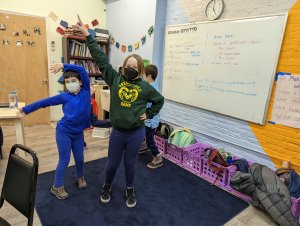
Nitzanim is continuing to explore themes of nature and appreciating the earth through our showcase project and through text study! We created some awesome haikus about trees and nature (snaps all around for our Nitzanim poets). Kiddos are continuing to work out our showcase project, in which we’re using symbolism from the Tu B’Shvat seder to represent what makes each of us holy!
Next week, we will discuss more about Honi the circle maker and wonder about the world around us, how we cope with things we can’t control, and the importance of cycles and circles in Jewish tradition.
